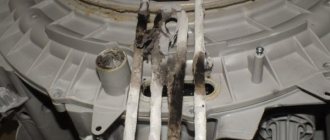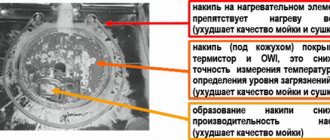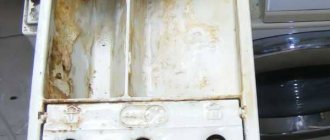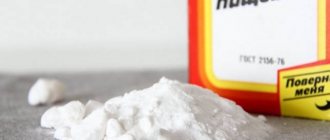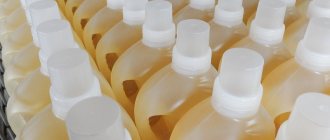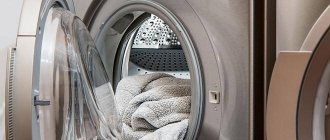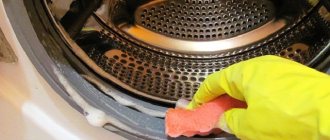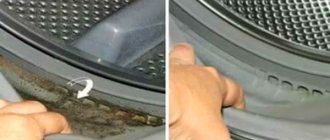All owners of washing machines know that equipment from time to time needs to clean the internal parts from dirt and deposits. Even with careful use of the machine, it is impossible to prevent the appearance of scale that occurs due to exposure to untreated tap water and chemical compounds in washing powder.
You can effectively clean your washing machine using regular table vinegar.
Many users wonder whether it is possible to remove scale, dirt and get rid of unpleasant odors using acetic acid. Let's talk about this further.
Is it possible to clean a washing machine with vinegar?
During operation, the washing machine interacts with a large amount of tap water. Unfortunately, the latter is not of high quality; most often the water in the pipes is hard, with a large number of mineral impurities. Therefore, over time, scale forms on the internal parts of the machine, impairing the operation of the unit.
Cleaning the washing machine is required not only because of scale. After numerous washes, ordinary dirt accumulates in the device - small threads, hair, pet hair. Powder residues may settle in the drum and tray, and mold will gradually develop due to increased humidity.
Vinegar helps remove scale from the internal parts of the washing machine.
Regular cleaning of the unit helps eliminate scale, fungus and bacteria. You can use regular vinegar as a cleaning agent. It has good disinfectant and dissolving properties, removes limescale and eliminates unpleasant odors.
We recommend reading: How to remove brilliant green from linoleum
How to remove musty smell?
The characteristic musty smell is a clear sign that your washing machine needs hygiene procedures. As a rule, the standard treatment of the drum with vinegar and dry washing according to the instructions described above can restore the aroma of cleanliness.
You can clean your washing machine with citric acid to get rid of musty smells.
Pay special attention to the sealing collar - this is where most of the debris and dirt accumulate, which causes the stench . If the usual procedures do not help, you will have to deal with the unobvious reasons for the appearance of odors:
- old drain hose;
- accumulation of residual water in the drum due to improper connection of equipment to the water supply;
- dirty drain filter;
- unsuccessful change of powder or conditioner;
- long-term storage of dirty laundry in a drum;
- lack of natural ventilation due to a tightly closed door.
Eliminating these problems will automatically help get rid of the stench that causes a lot of discomfort.
What kind of vinegar is added to the washing machine?
Universal table vinegar 9% is suitable for caring for household appliances; it can be poured into the tray undiluted. But if you don’t have such a product at hand, you can clean the washing machine with 70 percent vinegar. First you just need to dilute the essence with water in a ratio of 1 to 7.
9% acetic acid is best for cleaning a washing machine.
How to clean a washing machine with vinegar and soda
The internal cleaning of an automatic machine can be done in two ways. The most common one suggests using only a vinegar solution to care for the unit; another option recommends adding soda powder.
We recommend reading: Baking soda: beneficial properties, uses, how to take
The traditional option for cleaning a washing machine with vinegar
To clean your washing machine with vinegar from odors and scale, you need to follow this algorithm:
- The laundry is unloaded from the drum of the device and checked to see if there are any unnoticed small items left inside.
- 150 ml of acetic acid 9% is poured into the powder compartment. If necessary, you can mix 70% vinegar essence and water in a ratio of 1 to 7, and then pour the same 150 ml of solution into the tray.
- The door of the automatic machine is closed and the unit is set to the longest washing cycle at a water temperature of 60 degrees and above.
- 20-30 minutes after the start of washing, stop the operation of the automatic machine by pressing the pause button, and leave the unit in this state for 1.5 hours.
- During the specified period, the vinegar solution will have time to interact with all parts of the machine and will penetrate even into hard-to-reach places of the unit. When 1.5 hours have passed, the wash cycle will need to be resumed and wait until the end of the program.
To clean, you need to pour no more than 150 ml of vinegar into the machine tray.
Once cleaning is complete, you will need to unplug the washing machine, remove the drain filter located at the back of the device, and manually clean it of any remaining scale and dirt. After this, you will need to dilute another 50 ml of vinegar essence in 1 liter of water, moisten a sponge in the solution and wipe the inside of the unit drum and the door from the inside.
After cleaning with vinegar, it is recommended to remove and wash the drain filter separately.
After installing the cleaned drain filter in place, the machine is plugged in again and the wash is started again. This time no cleaning agents are added to the powder tray, and the shortest program is selected; repeated washing is needed to simply remove the remaining vinegar solution and scale from the unit.
Attention! All manipulations when cleaning the machine should be carried out wearing rubber gloves and a gauze bandage for the face. Vinegar solution is a fairly caustic household product, so it is better not to inhale its vapors and avoid getting the liquid on your skin.
Cleaning the washing machine with vinegar and soda
If there is a strong unpleasant odor from the unit and serious scale, you can also use baking soda. The algorithm in this case will look a little different:
- 50 g of soda powder is diluted with 50 ml of water to a paste;
- the product is placed in the washing powder tray;
- 200 ml of vinegar essence 9% is poured into the empty drum of the machine;
- run the machine in intensive wash mode at a temperature of 60 to 90 ° C for the longest cycle.
When cleaning with soda, acetic acid is poured into the drum, and soda powder is poured into the tray.
The spin cycle must be turned off when cleaning; if there is no laundry in the drum, this mode will not be needed.
Baking soda and acetic acid will have a double effect and help cope with even the most severe stains. At the end of the washing cycle, you will need to manually clean the drain filter in the same way and wipe the inside of the drum, and then start the machine without cleaning agents to rinse it with water from the inside.
Advantages and disadvantages of the method
Cleaning the washing machine with a bite gives the housewife at least 6 advantages:
- savings - low price makes the product accessible to everyone, even families with low income;
- crystal clear - vinegar not only removes dirt, but also effectively dissolves scale along with limescale;
- antibacterial effect - acid is destructive to mold and pathogenic microorganisms;
- safety for equipment - if the proportions of the cleaning components are observed, the working elements of the washing machine will not be damaged in any way;
- safety for humans - vinegar does not emit dangerous vapors and does not require the use of protective devices;
- pleasant aroma - unwanted odors and signs of mustiness will go away along with germs and dirt.
This method also has several disadvantages:
- Failure to comply with the proportions of components and the cleaning algorithm can lead to damage to parts of the unit, especially rubber seals;
- the pungent smell irritates some housewives who prefer to abandon vinegar in favor of other means.
The problem of a strong odor is easily solved - just add a few drops of any essential oil with a pleasant aroma to the cleaning water. Don’t forget to open the windows after completing hygiene work - the smell will quickly disappear.
Is vinegar harmful to a washing machine?
It's quite easy to descale your washing machine with vinegar. But despite its high efficiency and availability, the solution has some disadvantages; it can cause harm to the machine if used incorrectly or too frequently:
- The pungent smell of acetic acid after cleaning can remain in the machine for a long time. That is why it is important to put the unit into operation again after the cleaning is completed, this will allow the remaining solution to be washed out of the internal parts. You need to pour the strictly recommended amount of acetic acid into the detergent tray, no more than half a glass.
- The vinegar solution is completely harmless to the metal parts of the unit. But at the same time, it can damage silicone and rubber elements, primarily the sealing collar. As a result of cleaning, the elastic can become stiff and simply tear, so the procedure should not be carried out too often.
Acetic acid is dangerous for the rubber cuff, so after cleaning it must be rinsed separately
After cleaning, you need to open the drum of the unit and thoroughly rinse the cuff with a clean, damp sponge to remove any remaining vinegar solution. The drum and tray are left open for several hours or even a couple of days, this will help ventilate the device.
Advice! If the strong vinegar smell does not go away for a long time, you can run the machine in the “empty” wash mode and add a little scented fabric softener to the tray.
When processing things manually
A preservative is added not only for machine washing, but also for hand washing. It is used for a similar purpose: to remove stains, soften fabric and disinfect it. The solution is prepared according to a single recipe: for each liter of water take 1 tbsp. l. spoon of acid.
If things shed a lot, the pigment can be fixed by soaking them for 20-30 minutes in cool vinegar water.
To remove stubborn stains and ingrained odors, items are boiled in a vinegar solution. This is an effective way to clean greasy kitchen towels. They are soaked in an enamel basin, vinegar water is brought to a boil and left overnight. In the morning, towels are washed as usual.
Useful tips
If you follow a few simple recommendations when using an automatic washing machine, you will rarely need to clean the unit:
- The main cause of washing machine breakdowns is hard tap water with a high content of foreign impurities. To protect the internal parts of the machine from scale, it is recommended to install water filters. If this is not possible, you should use water softeners, for example, Calgon.
- In addition to chemicals, ordinary household products can help soften water. When washing, you can add baking soda to the detergent tray from time to time; it has a positive effect on the composition of the water and makes it less hard.
- In addition to scale, the automatic machine is damaged by fine dirt, which accumulates over time on the internal elements of the unit. Before washing, it is recommended to carefully check the pockets of clothing, as well as shake off items and brush them to remove small threads, hair, wool and dust particles.
- The most vulnerable parts of the washing machine are the sealing collar and the drain filter. Once every 2 months it is recommended to carry out a small cleaning of these elements. The cuff on the machine hatch can be regularly wiped with soapy water; the filter must be unscrewed and cleaned manually from accumulated debris.
When washing, you can use soda to soften the water, then scale will form more slowly
Important! It is recommended to disinfect a washing machine with vinegar no more than once every six months. With constant use of household solvent, the condition of the rubber elements will deteriorate, and the machine will, one way or another, require repair.
Cleaning the tray
It is recommended to clean the loading hopper after each wash cycle. Residues of washing powder and rinse aid accumulate in it. If you don’t do this, the tray will get dirty very quickly and you will need to put in a lot of effort to make it look like new (become perfectly clean).
Wipe down the tray after each wash cycle to help keep it clean at all times.
To remove the tray from your washing machine, look for the manufacturer's instructions. It details how to do this. If you accidentally lost such a manual, do not panic - almost all the instructions are available on the Internet, just enter the make and model of your washing machine into a search engine.
In many models (machines from Bosch, Beko, Samsung, etc.), to remove the tray you will need to press the blue (or green) button (located in the air conditioner compartment) and pull the tray towards you. Other models (for example, Indesit) do not have such a button. To remove the tray, just pull it forcefully towards you.
To remove the loading hopper, press the blue button and forcefully pull the container towards you
Cleaning the loading hopper of old contaminants is not so easy. Some SMA models provide a tray with a complex configuration, with a large number of recesses and protruding parts. Sometimes the tray even becomes covered with a layer of rust.
If you are dealing with old dirt, remove the tray and first soak it in a solution of warm water and vinegar for a day. Choose a suitable basin so that the tray is completely immersed in it. After this, just lightly wipe the hopper with a sponge and rinse it with running water. It will shine.
If you can't or don't want to wait that long and the bin is very dirty, you can use a solution of baking soda and vinegar. To do this, extinguish the soda with vinegar and apply the mixture to the walls of the powder receptacle, leave for a couple of hours and remove the deposits with a brush, rinse the tray very well and on all sides with tap water.
Cleaning the washing machine hopper with soda and vinegar
